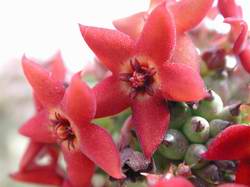Hoodia pedicellata (SCHINZ)
Plowes
(pedicellata
=
with
pedunculate flowers)
Hoodia pedicellata (Schinz) Plowes, Asklepios No. 56: 9. 1992
|
|
|
|
published in "Cacti and other Succulents" (KUAS, German original title "Kakteen und andere Sukkulenten) 54 (1) 2003: III-IV |
|
|
Ill. 1: Hoodia pedicellata in habitat Rössing Mountain near Swakopmund (Namibia). |
|
by Ulrich Tränkle and Friederike Hübner 1. First Description
Trichocaulom pedicellatum Schinz (1888), Verh. Bot.
Vereins Prov. Brandenburg 30: 266 2. DescriptionPlant: up to 20 or more stems branching out from the base; young stems ± erect, later between erect and reptant; 100 to 250 (-500) mm long, 25 to 50 mm thick. Rows: tubercles set up in rows of 11-20, each ending in a dark, 1.5 to 3 mm long spine. |
|
|
Ill. 2: Close-up to the flowers of the plant in Ill.1 (Rössing Mt. (Namibia).
Ill. 3: Young fruits are developing. |
|
Flowers: in groups of 1 up to 4, developing successively predominantly in the upper part of the stems. Pedicel: 4 to 12 mm long, smooth, bending down. Sepals: between 1.5 and 2 mm long, smooth, lanceolate, acuminate. Corolla: between 8 and 14 mm in diameter, nutant, subtly papillate, smooth in the centre as well as on the exterior. Chestnut coloured or between light and dark crimson, with faint tumefactions/protuberances in the connation area of the corolla lobes, tubercel < 1 mm, incorporating the basis of the corona, petals between erect and spreading, 3 to 6 mm long, 2.5 mm wide at the basis, lanceolate, acuminate, edges folding down. Corona: crimson or yellow, smooth, 3 to 3.5 mm in diameter, outer corona (interstaminal lobe) extending horizontally from the staminal column, parting midway or deeper into two straddled short little dents, laterally coadunate with the dorsal part of the inner corona (interstaminal lobe); inner corona ascending from the level of the outer corona and bent inwards, frequently meeting in the middle, obtuse, and highly variable in length. Fruits: follicles of a fruit pair straddled between 170° and 180° in ripe condition, each 7 cm long and equipped with 25 up to 30 seeds.
Description according to
Bruyns, P. V. (1993): A
revision of Hoodia and Lavrania (Asclepiadaceae - Stapeliae).
Bot. Jahrb. Syst. 115(2): 145‑270
ergänzt um die Fruchtmerkmale. 3. Distributional RangeExclusively in the Namib desert region of advective fog south of Swakopmund in Namibia ranging closely to the north of Foz do Cunene in South-West Angola. Distribution assumedly confined to an 80 km wide coastal strip. 4. CultivationHoodia pedicellata prefers purely mineral, fluffy substratum, well permeable to water. An acidic substratum, e.g. with granite, is clearly favourable, though the root system in an alkaline substratum can hardly be distinguished from one in an acid substratum. Accumulated heat and full sunshine combined with high temperatures should definitely be avoided, as H. pedicellata is inclined to dry up or suffers burning of the shoot apexes. Impeded drainage and high humidity, especially in combination with temperatures below 10° to 15° should definitely be avoided even though this species does not easily attract fungus rot. |
|
|
Ill. 4: Close-up to cultivated plants. |
|
New rooting requires a lot of patience and caution and should best be done in penumbra and pure siliceous sand, adding water cautiously, but constantly. There is a high risk of decay. Overwintering is possible at a temperature of ± 10 °C – higher temperatures as for instance on a freely suspended shelf are also advantageous. Grafting has proved successful on Ceropegia woodi, resulting in a vigorously flowering and potently branching out plant. Reproduction is best accomplished by seed which is however unfortunately very hard to obtain. 5. CommentsH. pedicellata is rare in collections since there is hardly any seed or plant material on offer. Only few specialists suceed in hand pollination, as the plant's pollinia are oily and slippery which makes the already complicated pollination process typical for stapeliae even more difficult. Spontaneous frutification is very rare, the species is however apparently self-fertile. There are no known hybrids. In summer, H. pedicellata flowers distinctly constant and opulently. The smell characteristic for many kinds of stapeliae is rather discreet. |
|
|
Ill. 5: Ripe fruit of Hoodia pedicellata (handpollinated). |
|
Bruyn's revision of the species Hoodia and Varania (1993) moved H. pedicellata from Trichocaulon to Hoodia sect. Trichocaulon.
|
%201%20HT.jpg)
%202%20HT.jpg)
%206%20HT.jpg)

